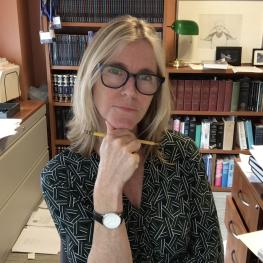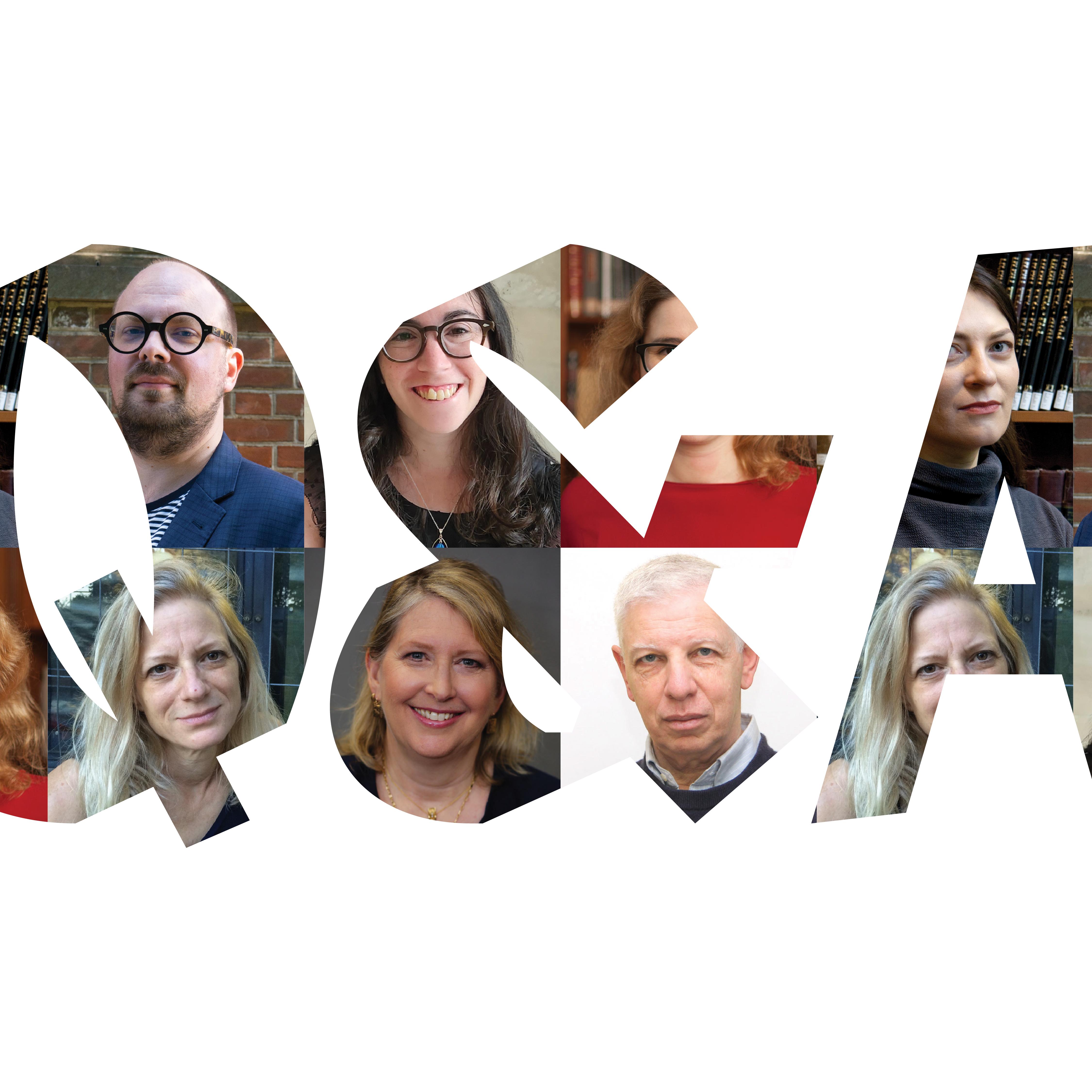Q&A: Katz Center Fellow Xandy Frisch Centers the Religious Body in Her Understanding of the Dead Sea Scrolls
Q&A: Katz Center fellow Xandy Frisch sees changing religious purity laws as evidence of communal trauma

Natalie Dohrmann (NBD): Xandy, tell us a bit about your broad scholarly interests, what drew you to them, and what especially excites you about them personally and/or intellectually.
Xandy Frisch (XF): One thing we can say with certainty is that every religious person that ever lived has had a body. They ate, breathed, got sick, cried, laughed, felt pain. This seems obvious, but Jewish studies (and, to a greater extent, religious studies) has long had a Cartesian approach, separating the mind from the body and focusing more on discursive modes of understanding related to theology, law, or interpretation. Given that the bulk of the evidence that remains of early Judaism is textual, this approach makes sense. However, it isn’t the only approach. I consider myself part of what has been a more recent “bodily turn” in the field, endeavoring to consider not only what the texts show us about what these Jews thought and believed, but, also, what they can tell us about what these Jews did and experienced. During this fellowship, I realized that many of the other fellows are thinking about texts in just this way, even if hundreds of years separate our sources.
NBD: Your project here at the Katz Center sets itself a daunting task: getting at physical and psychic experience from textual remains from two millennia ago. Tell us about the methodological challenges, and the opportunities, afforded by bringing your research questions to the deep past.
XF: I don’t pretend to be able to capture the experiences or feelings of specific Jews who lived two thousand years in the past. We can’t put anyone on the proverbial couch and diagnose them. This is the main methodological challenge. But I do think we can get at how larger Jewish communities responded to what were often chaotic and oppressive historical circumstances from the sixth century B.C.E. to the first century C.E. when Jews lived under Babylonians, Persians, Greeks, and Romans. To do that I have been using the work of trauma theorists, mostly those that focus on the sociological phenomenon of collective trauma and the ways that trauma can rupture communities. These theorists posit that if a group is to survive intact, then they need to reinvent themselves—create new narratives and/or communal rituals that reestablish bonds. It is these recovery strategies that I think we can see evidenced in the texts.
My contention is that the Qumran sectarians, as well as other Jews throughout Judea and the diaspora, developed a discourse and a practice of purity that helped to give them a sense of control in a world that felt out of control. Purity does this in several ways. It structures the world between that which is clean and unclean, so that foreign rulers, gentiles, and even empires themselves are all deemed impure. Having so relegated them, Jews could restrict interactions with impure (and dangerous) outsiders, thus, securing communal boundaries. But purity didn’t just have implications for the present, Jews also reimagined a primeval period in which these opposing forces were labeled impure from the time of creation. Impurity meant that there was no question of the condemnation of their foes, and this all finds expression in their apocalyptic worldview in which impure enemies are doomed, and pure Jews find eschatological salvation.
This is not to say that Jews weren’t still concerned with keeping pure for the sake of accessing the sacrificial cult. They were. But, what we see, then, is that Jews took advantage of a ritual system that already existed, extending it in new ways to help them negotiate life under power structures that often sought to harm, subjugate, or even destroy them. In other words, even if they couldn’t alter what was happening to them externally, early Jews could mobilize an internal power—their own bodies—to help the body politic.
On a related note, although I started on this project before October 7, I have only become more convinced of the relevance of considering trauma in our study of Jews and Judaism. I think anyone reading this will recognize that horrific events obviously cause trauma to those who experience them, but also to their relatives, friends, and larger community, stretching even to other countries. Similarly, much has been made of how October 7 has triggered latent (or not so latent) Holocaust trauma, affirming its transgenerational effects. Antisemitism is experienced on a visceral level because it is read through centuries of memories and embodied fear. I am convinced that scholars of contemporary Judaism would agree that the current moment of trauma is changing and shaping Judaism in new ways. My research similarly raises the possibility that earlier historical traumas—exile, loss of sovereignty, persecutions, destruction, war, massacre, martyrdom—were also determinative in shaping ancient Judaism.
NBD: Can you share an example of a strange, or favorite, or understudied passage or motif that you are reading anew through your bodily lens?
XF: What a fun question! The following passage is one that was new to me as I did my research. It is in the Septuagint’s Greek version of Esther, which adds a lot to the biblical narrative, including a lengthy prayer in which Esther beseeches God to save her and her people. As a part of her personal appeal for courage before going to the king, she implores God, saying:
You know all things, O Lord; you know that I hate the glory of the unrighteous and abhor the bed of the uncircumcised and of all the heathen. You know my necessity, for I abhor the sign of my high estate, which is upon my head in the days when I show myself, and that I abhor it as a menstruous rag, and that I wear it not when I am in private by myself. And your slave has not eaten at Haman’s table, and I have not honored the king’s banquet nor drunk the wine of libations (LXX Esther 14.14–18).
This is a written passage about spoken words, but let’s consider it from an embodied perspective. All the evidence that Esther cites to prove her faith has to do with her body and the bodies of those around her. She doesn’t want to have sex with Antiochus because he is uncircumcised. She doesn’t want to eat or drink with Haman and the other Persians. Most striking to me, however, is the insult she hurtles at the king, calling her crown “a menstruous rag.” Let the imagery sink in. The visualization of it is quite disturbing. The writer of this text is employing the Levitical language of ritual purity, knowing full well that the reader will react with horror at this association (I think modern readers might as well!). The menstruating woman is impure, and all who come into contact with her or even the objects that she has touched likewise become impure (Lev 15.19–24). However, the writer hasn’t used this image to deplore women but has used it to flip the script—it is not Esther, but royal power that is defiling. We, as readers, detest the king just as much as she does. Purity has become part of her negotiations with power.
NBD: Is there something special about a sectarian community such as that which produced the Dead Sea Scrolls—something in the extreme nature of both communal life choices of its members and writings—that makes it a unique sort of subject of research?
XF: There are two aspects of this sectarian community that make it a fitting subject for researching bodies and trauma. First, to state the obvious, it is a community. We have their rule codes that show how they operated hierarchically, organized themselves, admitted members, punished disobedience, and gathered. We have scrolls that detail the group’s perspectives on its own history and contemporary figures and events. We have texts that give us insight into their rituals and liturgies. And we also have an archaeological site full of ritual baths, a scriptorium, and a large dining hall that allows us to glimpse the space in which they lived. The result is that, more than for any other group of Jews from the Second Temple period, we can reconstruct not only what they believed, but something of their lived experience. How did they spend their days? What were the environments in which they moved? What sorts of emotions did their life in the Judean desert elicit?
The scrolls give us a great snapshot of a community’s life, but they also reveal a community of people who were outliers. We aren’t even sure what they called themselves! So the second aspect that makes them relevant for this research is that, because they were a relatively closed, exclusive community, they had beliefs and practices that were unique to them, and which don’t continue into normative Judaism. For example, they saw themselves as living in the last days and were waiting for an apocalyptic battle between the Sons of Light and Sons of Darkness that would usher in a messianic period (with two messiahs!). They were afraid of those Sons of Darkness, which included the rest of Israel as well as foreign nations and evil spirits. Everyone was their enemy. This mentality begs the question—what had happened to them to make them view the world in such a way?
It is my contention that they had experienced what we would consider to be a collective trauma. Regardless of whether their own account was historically accurate or not, they saw themselves like the earlier Babylonian exiles, driven away from Jerusalem, living disconnected from their promised position in the Temple and persecuted by both Hasmoneans and Romans. To my mind, this helps to explain their purity practices, which extended beyond what other Jews were doing. They were celibate. They were all males. Approximately ten ritual baths served the members, who purified themselves daily before partaking of meals. They altered what it meant to be pure, requiring repentance before immersion. They believed that impure spirits could possess their bodies and needed to be exorcised. They made sure to keep pure so they would be ready for an apocalyptic battle in which they would fight alongside angels. The surprising realization that I came to is that the sectarians weren’t alone in these purity concerns—other Jews also started to construct ritual baths, for example—they just took them to the extreme. In this way, focusing on Qumran, although it was unique, helped me to reconsider how purity was functioning more broadly in Second Temple Judaism.
NBD: Has being part of a residential fellowship made an impact on your scholarship? If so, how?
XF: It was a privilege to be a part of this cohort of fellows, who truly show how diverse and expansive the field of Jewish studies is. I would often tell anyone who asked that the residential fellowship was like being back in graduate school, but without all the stressful parts! My academic positions have been in religious studies departments where I’m often the only one from Jewish studies, which means I rarely get to engage with colleagues in Jewish studies outside of conferences. It was great to immerse myself in learning about the projects of other fellows, which felt like taking mini courses on everything from contemporary ultra-Orthodox Jews to early modern Jewish ghettos, to rabbinic mourning practices. Practically speaking, the fellowship also helped to reacquaint me with the process of working on a book project, which I haven’t done since my dissertation/first book in graduate school. The seminar is an opportunity to receive valuable feedback at an early stage in that process. Having the chance to get the ideas out of my head and in front of other scholars functioned as a sort of trial run that changed the direction that my research took this year, so much so that the book that I ended up writing doesn’t resemble my application proposal. I hope that is the sign of a fellowship well spent!




